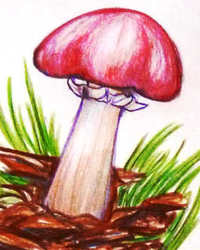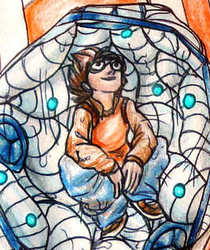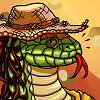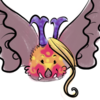Sign In
CloseMushroom Guidesheet #2--Oysters and Their Mimics by SpiderMilkshake (critique requested)
:D A handy cheatsheet guide to determining if, truly, what you have poppin' out of your local stump are oyster mushrooms or a close relative. While oysters are a good beginner mushroom to forage they do have a number of look-alikes, most of which are also edible mushrooms. However, a few are mildly toxic and should be avoided, and it's always smart to exactly which mushrooms you're eating, oyster or edible relative.
Key Pleurotus ostreatus (True Oyster or Winter Oyster) traits:
-Always grows from wood, typically hardwoods that still retain some of their bark layers.
-Grows out in flat, gilled shelves in dense clusters that often share a stem.
-Pale gills, from pure white to cream colored, which run in parallel down the visible stem portion.
-Thick, substantial cap flesh and meaty stems which are almost always off-center. Most of the time, oyster mushroom caps and stems will be shelf-like, with no gills developing on the back side at all (this might be different if the mushroom is growing straight up from the top of a log or stump.
-Spore print of oysters is always white.
-Unusual but pleasant aroma, most similar to aniseseed.
-Cap color is usually tan or grey, with a variance in darkness and hue. The cap will always be darker than the stem and gills.
-Large size, usually the mature, flattened out caps will be no smaller than 2 inches across.
Pleurotus pulmonarius, also known as the Summer Oyster, is a close cousin and is also a very choice edible. The differences are:
-Summer species can only be found in, you guessed it, summer months.
-Cap is usually somewhat paler than the Winter Oyster.
-Prefers growing from the top side of logs and stumps, maturing into almost tubular fan-shaped mushrooms. It is overall a longer stemmed mushroom that does not spread out to as wide a shelf.
Another oyster species, not pictured, is the Golden Oyster (Pleurotus citrinopileatus), which is identical to Summer Oysters except for its lovely golden color.
Oyster mushrooms, after the common Button Mushroom and Shiitakes, are one of the most often cultivated species in the world with growing them in straw substrate in greenhouses the most common method. They are even reported to thrive in and sprout from old spent coffee grounds! Kits can even be bought online where everyday mushroom lovers can grow huge tufts of tasty 'shrooms from a box indoors. Most cultivated oysters are the winter species, Pleurotus ostreatus.
There are plenty of relatives and mimics to Oyster Mushrooms found growing on various types of wood throughout the world, and in the interests of celebrating them and foraging safety I have included illustrations of them on the right side of the page as well.
Late Fall Oyster/Olive Oysterling:
This mushroom is an edible and medicinal mushroom, most commonly foraged for food in Japan where it is known as Mukitake, though it can be found across the entire northern hemisphere in temperate forests. It is extremely oyster-like in shape and growing habits, and typically appears in, you guessed it, late fall (and sporadically in winter warm spells). They are frequently enjoyed by deer and squirrels as a food source in winter.
Panellus serotinus identification traits:
-Oyster-like cap and stem arrangement, with branching shelves of caps being the common growth pattern.
-Cap color is usually a faint olivey green, though it can also be brownish or tan.
-Gills are cream-colored and run to the stem where they attach. Unlike Oysters, the gills do not run all the way down the stem.
-Stem is thick and stubby, often branching to form multiple caps.
-Typically smaller than an Oyster mushroom, cap size between 1 and 1.5 inches across.
-Spore print is cream colored, buff, or light tan.
Crepidotus species:
Crepidotus species, often referred to as "Creps", are generally not regarded as edible though none are known to be dangerous. They can often be mistaken for small oyster mushrooms by novice foragers but there are many observable differences between the two genera. Pictured is the most common Crep in the Eastern U.S., Crepidotus mollis or Crepidotus crocophyllus, the Hairy Crep which has very obvious wiry hairy structures on the cap and a pale orange to yellow cap.
Crepidotus identification traits:
-Typically grows on more degraded wood, sometimes nearly disintegrated stumps.
-Colors range by species: can be white, tan, light orange, or yellowish.
-Almost never grows in clusters, more often in single caps scattered across the log or stump.
-Never has a visible stem, but instead attaches directly to the wood.
-Many have a slightly hairy or scaly cap skin which is easy to peel from the cap flesh.
-Cap flesh itself is very thin and insubstantial, watery.
-Gills are typically yellowish colored and do not run parallel. Instead, they all originate from a single central point where the cap is attached to the wood.
-Typically do not exceed 2 inches in cap width.
-Spore prints are orange-brown to brown, never white.
Elm Oyster (Hypsizygus ulmarius):
A pleasant edible mushroom that was once categorized as a true Oyster species, it has since been rightfully given its own genus. The Elm Oyster is always found on dead or dying Elm trees and from a distance looks exactly like a Winter Oyster. However, up close it has a few distinguishing characteristics.
Hypsizygus ulmarius identification traits:
-Always on elm wood, usually dying elms or recently dead trees.
-Has an off-center stem which is fleshy, tough, and pale in color with faint vertical striations running down it.
-Has pale, cream-colored gills which run slightly down the stem.
-Always lacks a stem ring (annulus).
-The tan cap, which tends to crack with age and lack of humidity, is slightly convex to flattened. Often has a few small scales or hairs on its surface.
-Often grows in cluster, though from individual stems that do not branch.
Ghost Mushroom (Omphalotus nidiformis):
A toxic mushroom that may be mistaken for Oysters or Elm Oysters in its native regions of Southeast Asia and Australia, but more important to learn lately due to spots of invasive populations in the rest of the world. This fungi is interesting for its non-culinary properties, for while it is toxic it is also a bio-luminescent species that glows a wonderful lime green color in the dark. It is a close relative of the bright yellow-orange Jack-o-lantern Mushroom, Omphalotus olearius--which is also toxic and bio-luminescent!
Omphalotus nidiformis identification traits:
-Grows on degraded wood most often.
-Has a mostly-central stem. Often grows in branching clusters, but never in shelf-like clusters.
-Cap flattens rapidly with age, often becoming upturned at the edges.
-Cap is whitish in color, typically with a dark stained area towards the center.
-Gills are pale and run down the stem somewhat.
-Glows in the dark.
-Lacks an annulus (stem ring).
-Spore print color is white.
Angel Wing (Pleurocybella porrigens):
Well now... this would have to be my first "controversial mushroom" I cover, as it has sparked some fear due to recent 2004 and 2005 deaths attributed to it in Japan, where it is known as Sugihiratake. To date over 40 people, all in Japan, have reported severe poisoning symptoms after consuming this species of mushroom. However, especially in the Pacific Northwest, this species is foraged and consumed with no incident. I'm not convinced this is the "deadly toxic mushroom" often warned about in top ten lists... I'm actually pretty sure this is an edible mushroom with possibly a high number of allergic people or a variant population in Japan only which is toxic. Another theory is that a certain locality of these Angel Wings is contaminated somehow, and the mushroom is picking up the toxic contaminants. I'm going to go forward saying this is an edible species, provided a forager uses caution and avoids specimens gathered in Japan specifically.
Pleurocybella porrigens identification traits:
-A purely white mushroom, growing in oyster-like, ruffled shelves with very little to no stems.
-Very wide caps with thin flesh, similar to a Crepidotus.
-Found often in late summer months.
-If it has a short stem, the closely-bunched gills will run down it similar to an Oyster mushroom.
-Typically found growing on conifer trees and wood, not hardwoods.
-Spore print is white.
-Caps are typically smaller than Oysters, between 1 and 2 inches wide (though some have been found as large as 4 inches wide).
-Faint, mossy aroma which is sometimes sweet (not like aniseseed).
Mock Oyster (Phyllotopsis nidulans):
A beautiful but toxic mushroom that is sometimes mistaken for oyster mushrooms by very inexperienced foragers. While it does have a similar growth pattern to Oysters and fruits at the same time, it is rather distinct from true Pleurotus or any of its mimics. Never eat this fungus as it is known to be quite toxic, causing vomiting and painful cramps that may last for 48 hours or more.
Phyllotopsis nidulans identification traits:
-Pale yellow to bright orange mushroom growing from degraded wood of all types.
-Branching, thick stems and growing in large clusters. Sometimes the stems are so fused that they sprout multiple caps from each other rather than the stems.
-Sometimes has a foul smell, particularly when it grows in abundance.
-Top of the cap has at least one thickly hairy zone (an Oyster will never have hairs on the cap!).
-Gills run to the stem, but do not run all the way down it.
-Spore print color is pale pink.
Happy oyster foraging, and remember the safe mycophage's motto: "When in doubt, throw it out!" :D
Submission Information
- Views:
- 692
- Comments:
- 1
- Favorites:
- 4
- Rating:
- General
- Category:
- Visual / Traditional






Link
LycheeMonster
° 0 °